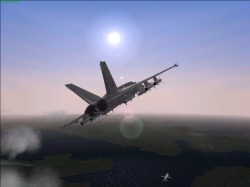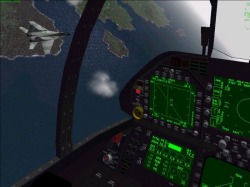|
JANE'S F/A 18 : Interview
by Leonard "Viking1" Hjalmarson |
||||
|
The net result of this modifier is that the airplane "feels" different at high altitudes (where the air is very thin) than at low altitudes (where the air is more dense). Since we calculate this "on the fly", we gain an infinite variation in our aerodynamic effects, and thus the feel of the aircraft. The next thing that we do is accurately simulate all control surface movement on the aircraft. These simulations can at times become very complex, especially on the F/A-18. The F/A-18 has some non-standard ways of using control surfaces. One example is the use of leading edge flaps as lift devices during landing and high AOA situations. We have painstakingly simulated all of the "scheduled" interactions of the various control surfaces. Once it is determined what a control surface should do (which comes from the CAS - which I will talk about below), the movement is then limited based on actual rates of movement, range limitations, and various interactions with other control surfaces. We simulate exactly what the real aircraft is doing. When the real aircraft commands a certain aileron movement to effect a certain roll rate at a given altitude - we also calculate that very same movement. We are modeling the exact same things that keep a real aircraft in the sky. In simple terms, we now have atmosphere and control surfaces that are positioned correctly. What we do next is determine what kind of linear forces and rotational moments are created on the body of the aircraft as a result of the forces generated by the control surfaces. We use what are called "dimensionless derivatives."
 TALD Dimensionless derivatives define the force that is created when a change in position occurs over time. These numbers, coupled with lots of other modifiers ultimately determine how much force a control surface is commanding given its current position, the dynamic pressure, and speed of the aircraft, as a few examples. Only when these derivatives (or numbers) are correctly combined in force buildup equations are we able to start to define the magnitude of forces that are acting upon the airframe. So, how do you get these kind of numbers? This is the whole reason for wind tunnel testing. When aerospace engineers begin designing an aircraft they calculate aerodynamic properties based on well defined formulas. These formulas are very complex and accurate, but are static in nature. |
 MiG over Russia Since engineers need to understand how an aircraft behaves throughout various regimes of a flight envelope, they use the only dynamic thing available to them - wind tunnel tests. This is where most of the aerodynamic tuning of an aircraft takes place before it is even manufactured. It is important to point out that nobody can possibly know everything about how a specific aircraft behaves throughout an entire flight envelope based solely on static calculations. One other interesting thing to note is that the aerodynamic characteristics of an airplane in motion change radically with altitude, speed, AOA, weight, and so on. This is where a lot of work went into the F/A-18 flight model. Given the correct application of these numbers, in combination with the control surface positions, dynamic pressure, speed, AOA, etc., we are able to create the three major linear forces of the aircraft defined in lbs., as well as the three major angular moments on the aircraft defined in ft./lbs. Combined, these forces define a 6 degree of freedom flight model. Once we have generated these aerodynamic forces and moments on the aircraft, we then feed these numbers in a highly accurate physics model that generates linear and rotation accelerations based on the planes mass and inertia, respectively. One of the reasons that our physics model is highly accurate is because of the high sample rate used. It also takes into account all of the complex aerodynamic inertia couplings that occur in the real world. Once we have generated accelerations we can then generate velocities. These velocities are then used to update the aircraft's position in the world. One of the most complex part of creating a state-of-the-art, modern jet flight model is to accurately model the control augmentation system - the CAS. The CAS is in many ways what gives the airplanes its "feel." CAS systems are typically designed to monitor a pilots input command, and adjust control surfaces appropriately based on the given flight conditions. Jane's F/A-18 has one of the most accurate CAS system simulations that I am aware of. We use realistic control loops in all of our various trim systems, as well as our numerous autopilot modes. Our CAS is designed just like the real thing, allowing us to place the player in a very powerful, but safe aircraft. GO to Part IV
|
|||
|
Copyright © 1997 - 2000 COMBATSIM.COM, INC. All Rights Reserved. Last Updated October 29th, 1999 |
||||
